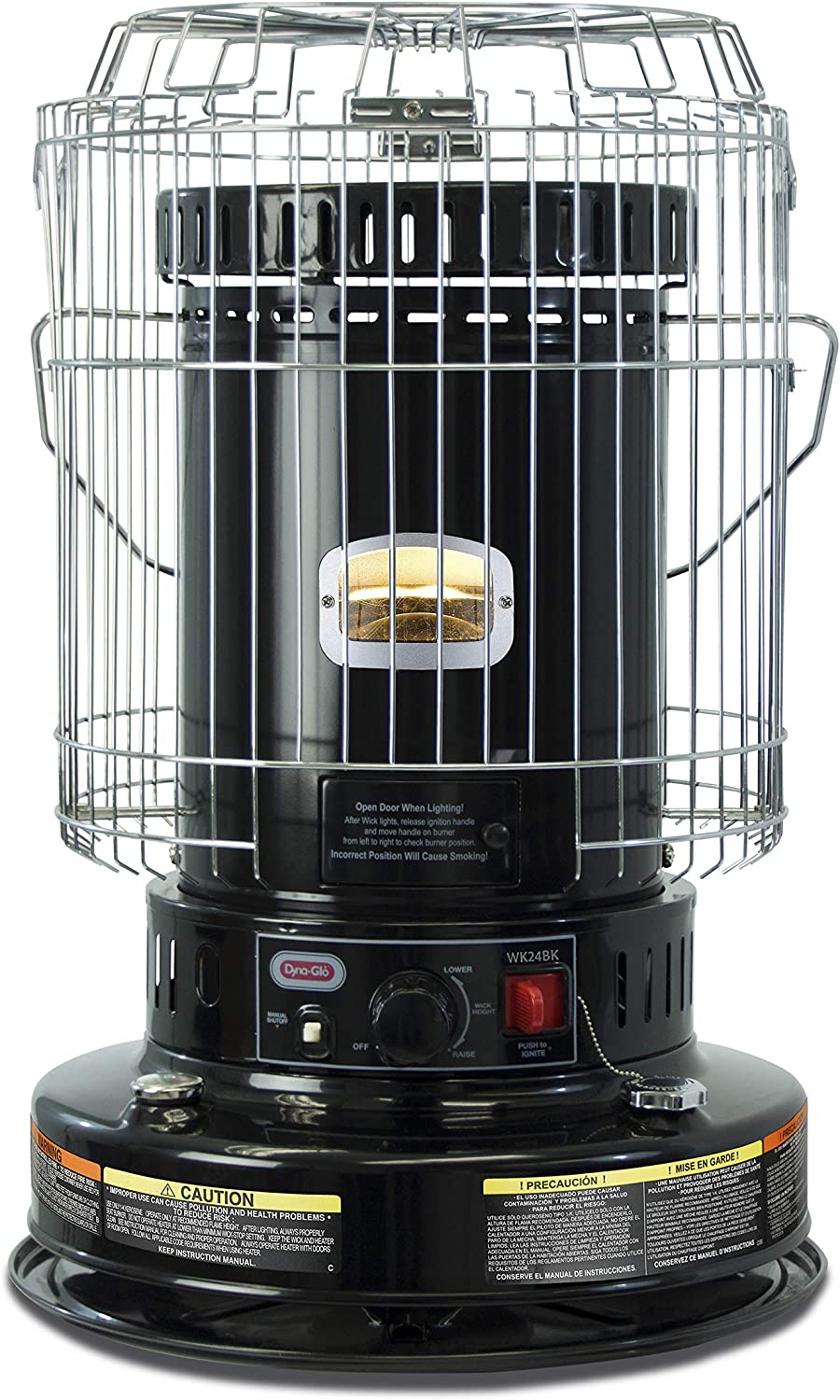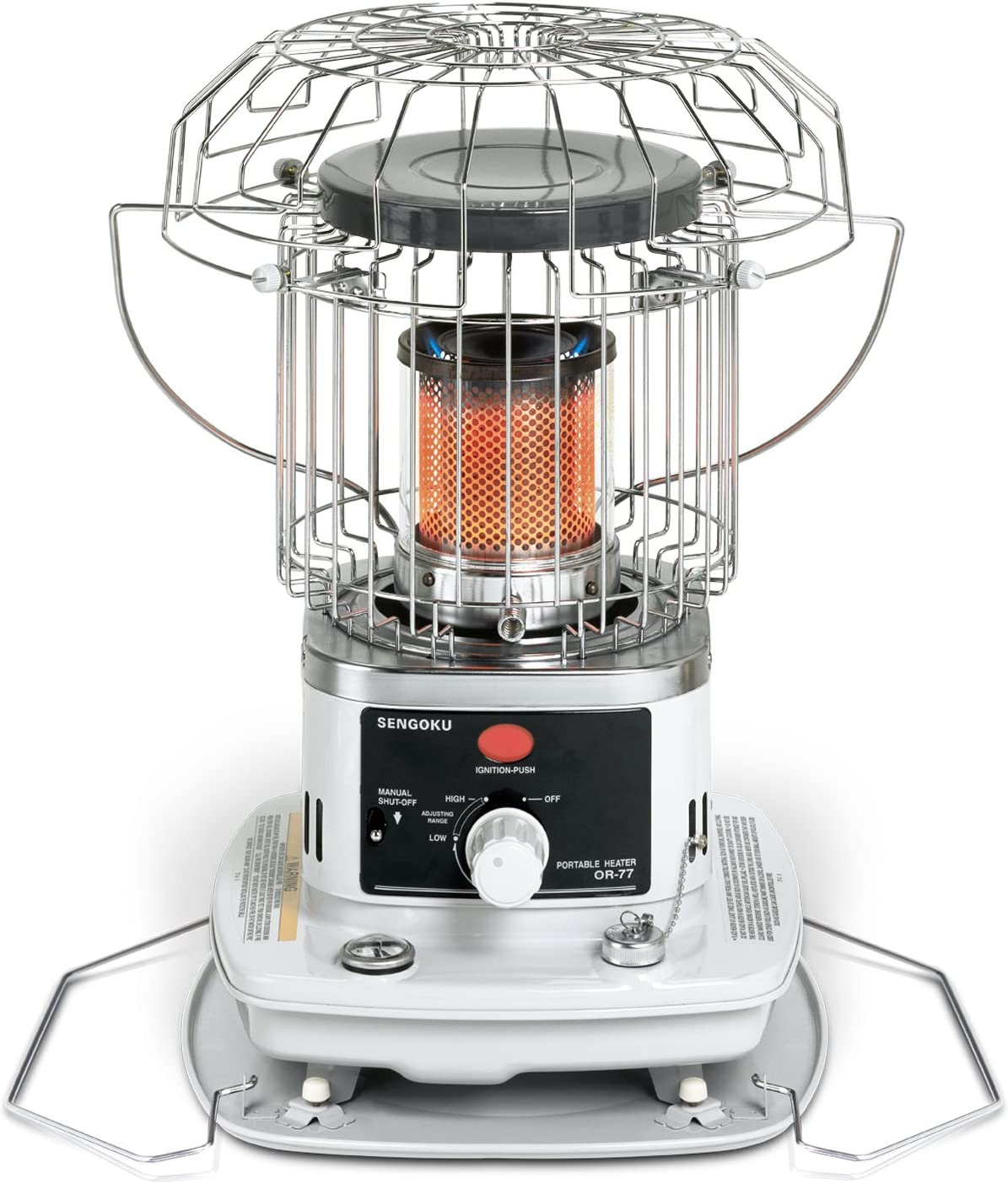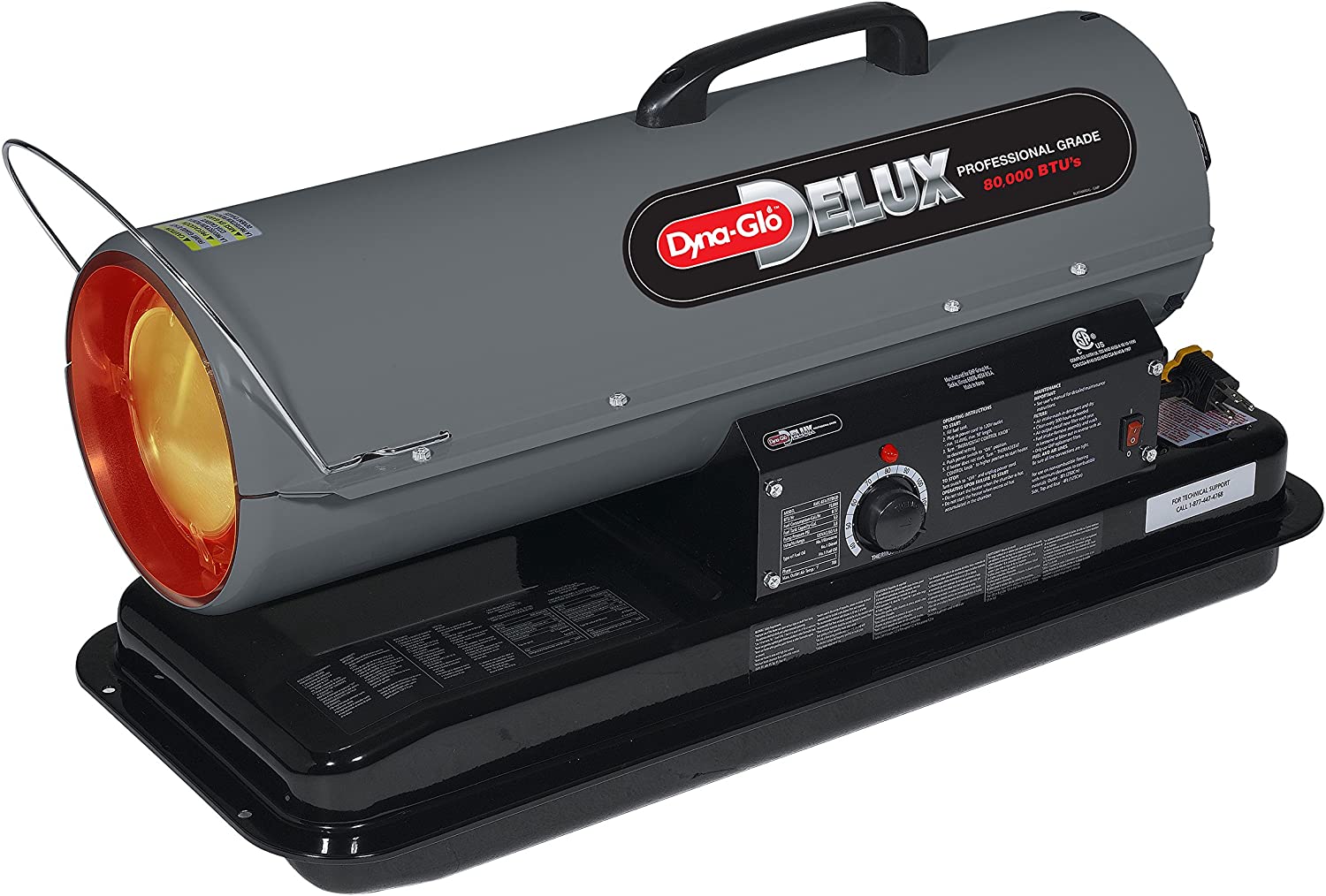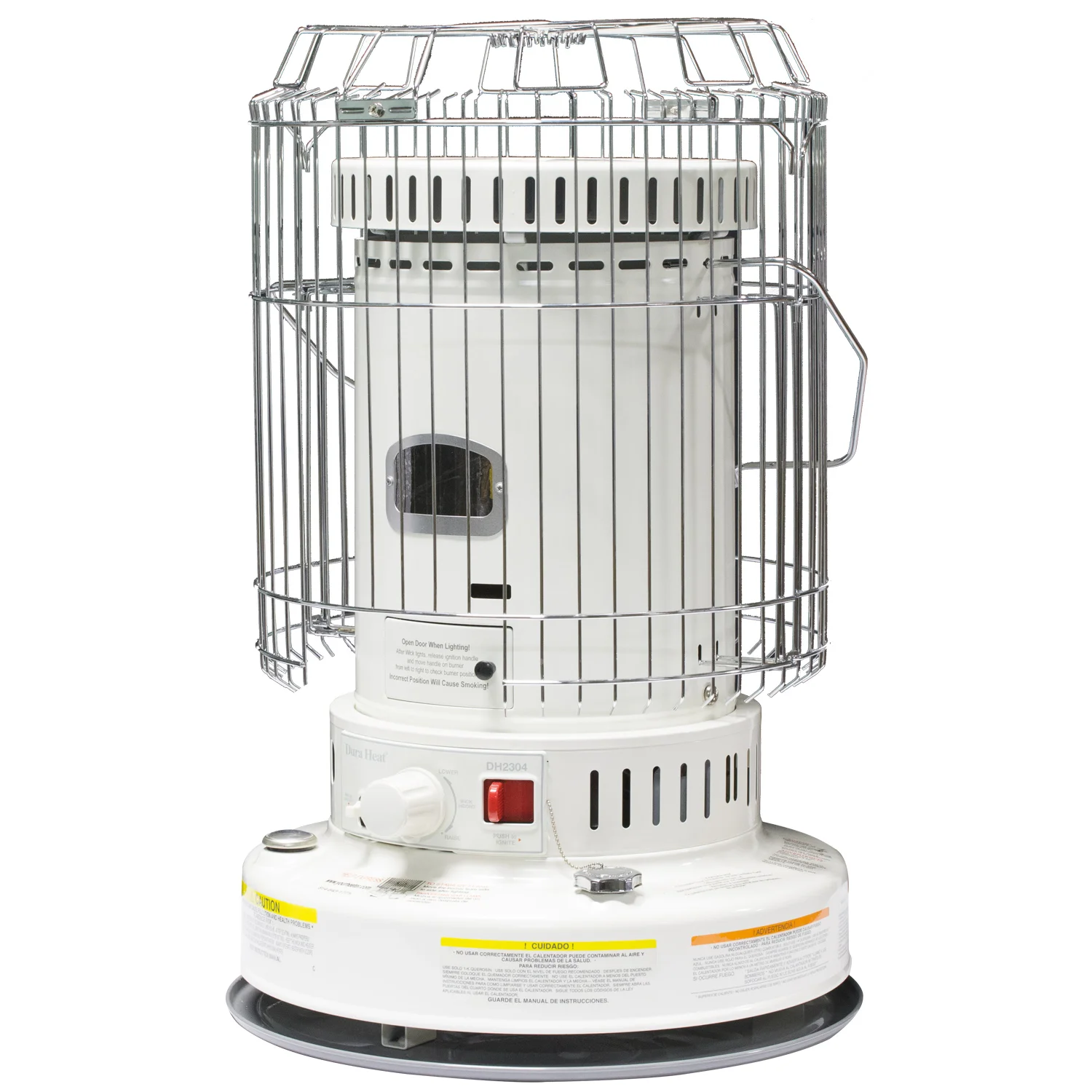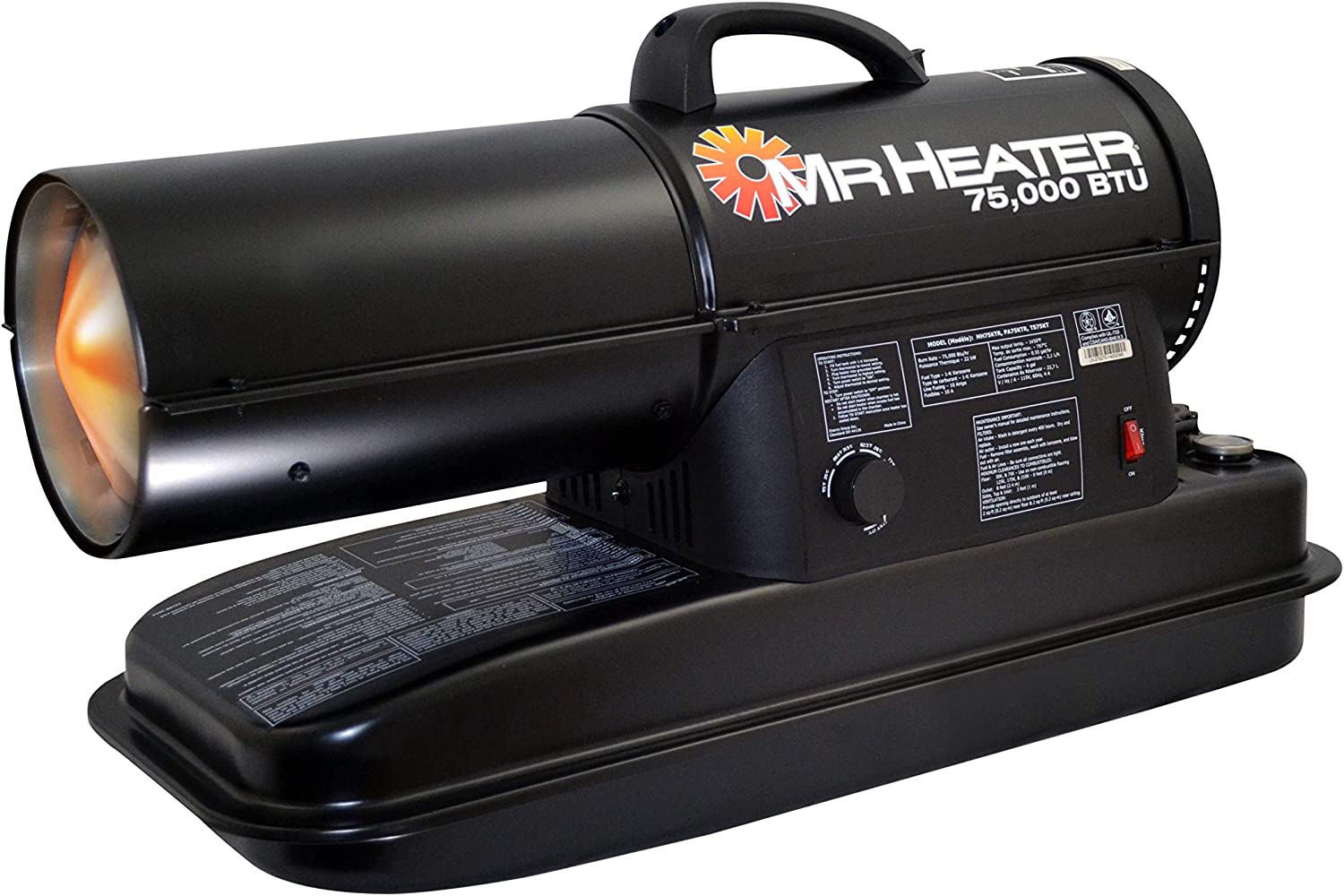Kerosene heaters are essential for providing warmth during power outages or cold winter seasons. Electric heaters are not always ideal, especially in remote areas. Thus, kerosene heaters work well indoors and act as a backup to provide heat.
Kerosene heaters come in varying sizes, models, and designs, making it challenging to pick the right option. Choose small kerosene heaters for indoor spaces (dining room and lounge) and large heaters for large areas (garages and warehouses). Scroll below for more tips on choosing the best kerosene heater for indoors.
Related: Best Space Heater for a Large Room – 10 Models to Consider in 2023
Table Of Contents
- 1 Features to Look for When Choosing the Best Kerosene Heater for Indoor Use
- 2 5 Best Kerosene Heaters for Indoor Use
- 3 Best Overall Kerosene Heater for Indoor Use
- 4 Best Small Kerosene Heater for Indoor Use
- 5 Best Indoor Kerosene Heater with Thermostat
- 6 Best DuraHeat Kerosene Heater for Indoor Use
- 7 Most Powerful Kerosene Heater for Indoor Use
- 8 Are Kerosene Heaters Indoor Safe?
- 9 What are the Dangers of Kerosene Heaters Indoors?
- 10 Can You Leave a Kerosene Heater on All Night?
- 11 Can You Get Carbon Monoxide Poisoning From a Kerosene Heater?
- 12 How Long Does a Gallon of Kerosene Last in a Kerosene Heater?
- 13 Do You Need Ventilation When Using a Kerosene Heater?
- 14 Do You Need to Crack a Window When Using a Kerosene Heater?
- 15 Is a Kerosene Heater Better than Propane?
- 16 Is Kerosene Heater Cheaper than Electric?
- 17 Can You Use Regular Kerosene in a Kerosene Heater?
- 18 How Do You Light a Kerosene Heater for the First Time?
- 19 Conclusion
Features to Look for When Choosing the Best Kerosene Heater for Indoor Use
Suppose you seek to know more about picking the best kerosene heater to suit your needs, especially if you want to enjoy the warmth of a top-notch kerosene heater. Here are vital aspects to consider while shopping for a kerosene heater.
Related: 5 Best Mini Split Heat Pumps for Cold Weather
BTU Rating and Coverage Area
British Thermal Units (BTU) is a unit’s measure of energy produced. Kerosene heaters come in varying BTU outputs because some are designed for small rooms while others are used for much larger spaces. The higher the BTU volume, the more heat output a heater produces. Kerosene heaters usually have 10,000 to 200,000 BTU ratings.
Select a model that has the right BTU rating to suit your purpose. Do not buy a kerosene heater with a higher BTU rating than you need because high BTU heaters will produce more carbon monoxide. Small heaters with a BTU rating of 10,000 – 25,000 are ideal for smaller rooms, patios, and porches. Small heaters produce good heat output to warm 300 to 1,000 square feet.
Midsize heaters produce heat within the 50,000 to 75,000 BTU range. They are perfect for warming spaces between 1,000 and 2,000 square feet. Large heater models have more than 150,000 BTUs. Large models pump a lot of forced hot air throughout a room; therefore, they are great for large backyard parties and semi-closed tents.
Before purchasing, measure the size of your indoor area where you plan to place the kerosene heater. For instance, multiply the dimensions (length and width) to calculate the area in square feet. The floor will be 300 square feet (20 X 15 = 300). One square foot requires 20 BTUs; therefore, a room needs 6000 BTUs (300 X 20 =6000). Purchasing a kerosene heater with 10,000 BTUs will provide essential warmth to such a room.
Related: Mini Split vs. Heat Pump: Which One to Choose?
Safety
Safety is a very pressing concern when choosing a kerosene heater. Kerosene heaters can start a fire or cause burns whenever misused; therefore, consider investing in models with protective shields or tip-over shut-off properties. Avoid placing the heater in a consistent movement path to deter potential dangerous threats.
A kerosene heater with many safety measures is better than a model with minimal safety measures. Ensure the heater is tested by agencies like Underwriters Laboratory (UL) or Factory Mutual (FM). Key safety specs include;
- Overheat protection: The kerosene heater should turn off automatically whenever the temperature is too hot. This enhances the heater’s longevity and safeguards your living spaces.
- Anti-tip switch: The switch prevents leakage and automatically turns off the heater, especially when the heater is accidentally knocked over.
- Air Monitor: The best kerosene heaters emit very little carbon monoxide. However, installing a working carbon monoxide detector for safety is good. Monitoring oxygen levels is crucial for your health.
- Fuel gauge: This is imperative in preventing overfilling
- Stable base: Heaters with a low center of gravity efficiently prevent potential toppling.
Fuel Capacity and Tank Size
Kerosene tank sizes are measured in gallons/ liters. Consider models with larger tanks if you don’t prefer to refill or change the tank often. Contrary, if you are using the heater rarely or only during emergency power outages, larger tanks may not be an ideal option because they occupy vast storage space and are difficult to carry when full.
Large-wheeled kerosene heaters have fuel tanks holding approximately 56 liters (15 gallons) of kerosene. On the other hand, smaller heaters can hold about 7 to 8 liters (1 – 2gallons) of fuel. Perfect tank size is relative to;
- Portability: Some heaters integrate wheels to ease mobility. Smaller heaters should be light and portable; hence, they incorporate smaller tanks.
- Heat output: Large heaters usually burn a high volume of fuel. Thus, they need larger tanks to hold the fuel.
- Fixed vs. Removable: Fixed tanks are usually larger than removable. The removable tank should be small and manageable.
Type of Kerosene Heater
All kerosene heaters run on liquid fuel and are available in varying models to produce different types of heat.
1] Convective kerosene heater
Convection kerosene heaters are round-shaped heaters Ideal for garages and large living spaces. The appliances are heavy in size and weight. They emit heat on all sides to evenly distribute heat conventionally and cover up to 360 degrees. They are potent machines to place at the center of a room.
2] Radiant kerosene heater
They are ideal for heating a target area like the sitting area. The appliances are smaller, compact, portable, and produce localized heat to warm objects in front of them. They don’t heat large spaces evenly. The heaters come with a removable tank to refill conveniently.
3] Forced air kerosene heaters
They are also known as torpedo heaters and salamanders. The appliances heat air and force it into the room like a furnace. The heaters get heated up quickly; hence, they are suitable for heating large outdoor tents and gazebos. They require electricity to run the fan. So, they aren’t a perfect option for power outages.
Runtime
Kerosene heater models offer different runtimes. Runtime is based on the tank size. So, bigger tanks will deliver extended heat runtime. Heaters with thermostats affect the maximum runtime of the equipment. Heaters running at a lower temperature will have a longer runtime than heaters running on higher temperature settings.
An ideal kerosene heater should run for several hours without refilling and burn about 99 percent of fuel, letting out minimal unburnt fuel. Best kerosene heaters can provide up to 12 hours before running out of fuel.
5 Best Kerosene Heaters for Indoor Use
The guide eases your searching and shopping process. We have compiled a comprehensive list of some of the best indoor kerosene heaters with in-depth descriptions, features, pros, and cons. Let’sLet’s dive in!
Best overall: Dyna-Glo WK24BK 23,800 BTU Indoor Kerosene Convection Heater
Best small kerosene heater for indoor use: Sengoku HeatMate 10,000-BTU Indoor Omni-Radiant Kerosene Heater
Best indoor kerosene heater with thermostat: Dna-Glo KFA80DGD 50,000 BTU Kerosene Forced Air Heater
Best DuraHeat Kerosene Heater for indoor use: DuraHeat Portable Convection Kerosene Heater
Most powerful Kerosene Heater for indoor use: MrHeater 75,000 BTU Forced Air Kerosene Heater
Best Overall Kerosene Heater for Indoor Use
Dyna-Glo WK24BK 23,800 BTU Indoor Kerosene Convection Heater
Dyna Glo is a famous brand in the production of kerosene heaters. Their 23,800 BTU convection heater leads in this article as the best option for use at home because it is easy to use and comes in the right size for indoor use. The heater only uses kerosene fuel to warm your living area, with an efficiency rating of 99.9%.
Dyna-Glo WK24BK boasts a vast heating capacity of up to 23,000 BTU; hence, it can heat the room very quickly. Its fuel tank can hold up to 2 gallons of kerosene with a runtime of 8-12 hours. The convection heater can heat up to 1,000 square feet for 4 – 5 hours when set at maximum. The heater comes with a removable tank that eases refilling. In addition, it has a fuel siphon to ease refilling.
The appliance has easy-to-use automatic ignition and a one-touch shut-off switch to alleviate potential threats. Dyna-Glo WK24BK indoor convection heater is designed to incorporate a flat-topped safety grill that allows you to heat food on top of it. The unique feature is perfect during power outages.
Features
- Type: Radiant heater
- BTU rating: 23,000
- Run time: 8- 12 hours
- Fuel capacity: 1.9-gallon fuel tank
- Safety specs: Emergency shut off and fuel gauge monitor.
- Efficiency rate: 99.9%
- Coverage area: 1,000 square feet
Best for: They are the perfect option for daily use on heating garages and home interiors during emergency power outages.
Pros
- Ideal for everyday use
- Long runtime period
- Decent heating capacity for indoor use
- It has a durable and robust construction
- Perfect for smaller homes
Cons
- Short warranty period. The heater is limited to a one-year warranty.
Check the Dyna-Glo WK24BK‘s latest prices on Amazon
Best Small Kerosene Heater for Indoor Use
Sengoku HeatMate 10,000-BTU Indoor Omni-Radiant Kerosene Heater
Whether you want to warm small places indoors or outdoors, Sengoku HeatMate radiant kerosene heater is a perfect appliance. The Sengoku HeatMate can heat living spaces to 380 square feet. It integrates a 1.2-gallon fuel tank and can run up to 14 hours.
Sengoku HeatMate radiant Kerosene heater comes with an in-built automatic off switch. The switch automatically turns off the appliance upon tip-overs and extreme heat conditions. The heater has a match and a lighter-free push button to start the flame. You can also adjust the throttling output using the EZ flame adjuster.
Sengoku kerosene heater has an easy-to-read fuel gauge. The monitor quickly indicates how much fuel remains in the heater. The quality of kerosene used may affect the runtime of the heater. The small heater won’t do much for large rooms.
Features
- Type: Radiant heater
- BTU rating: 10,000 BTU
- Run time: 12- 14 hours
- Fuel capacity: 1.2-gallon (4.5 liters) fuel tank
- Safety specs: Have protective safety grills, automatic shut-off, fuel gauge monitor, and tip-over switch
- Coverage area: 380 square feet
They are perfect supplement heaters for warming small indoor and outdoor spaces. They act as a great backup heater due to their fuel efficiency.
Pros
- It can last for up to 14 hours on a single tank
- Ideal for warming indoors and outdoors
- Affordable solution for a small environment
- Easy to assemble and use
- Efficient heat output
Cons
- Produces unfriendly odor over time
Check the Sengoku HeatMate‘s latest prices on Amazon
Best Indoor Kerosene Heater with Thermostat
Dna-Glo KFA80DGD 50,000 BTU Kerosene Forced Air Heater
This Dyno-Glo kerosene heater has varying BTU ratings ranging from 50,000 to 220,000 BTUs. The heater integrates many controls, including a thermostat to monitor temperature and fuel gauges to show fuel levels. It has a handle and flat-free tires that ease rolling.
The Dyna-Glo KFA80DGD offers massive heat to warm areas up to 1,900 square feet. It is designed to hold up to 5 gallons of kerosene that can run up to 9 hours. The heater features an automatic high-temp shut-off for safety.
Features
- Type: Forced air heater
- BTU rating: 80,000 BTU
- Runtime: 14 hours
- Fuel capacity: 5-gallon fuel tank
- Safety specs: Fuel gauge monitors and emergency shut-off
- Coverage area: 1,900 square feet
Best For Individuals who want to warm large spaces using a powerful heater.
Pros
- Large fuel capacity for elongated runtime
- It has built-in wheels for easy movement
- Easy to assemble and use
- Great heating power to cover large spaces
- Adjustable temperature
Cons
- Its fan needs to be plugged into a power source to work
- Highly expensive
Check the Dyno-Glo kerosene heater‘s latest prices on Amazon
Best DuraHeat Kerosene Heater for Indoor Use
DuraHeat Portable Convection Kerosene Heater
The DuraHeat portable kerosene heater has a heating capacity of 23,800 BTU. It heats conventionally, producing 360-degree heat to cover up to 1,000 square feet. The heater integrates a wire shroud around the appliance to prevent potential accidents.
The DuraHeat convection heater features an instant ignition to start the heater. It is designed to hold up to 1.9-gallons of kerosene fuel that can operate for 8- 12 hours. The heater has an Adjustable temperature dial to regulate the heat output. Its automatic shut-off turns the heater off when the space reaches 90 degrees.
Features
- Type: Convection heater
- BTU rating: 23, 000 BTU
- Runtime: 8-12 hours
- Fuel capacity: 1.9-gallon
- Safety specs: Tip-over shut-off and auto-shutoff
- Coverage area: 1,000 square feet
Best For Ideal for warming indoors and can serve as a backup heater during power outages.
Pros
- Portable and easy to move
- Provides universal warmth around the room
- Offers long runtime for a single tank
- Covers a large heating area
Cons
- Pricey compared to other kerosene heaters
Most Powerful Kerosene Heater for Indoor Use
MrHeater 75,000 BTU Forced Air Kerosene Heater
If you seek a highly powerful kerosene heater, look no further! The brand makes a wide array of powerful heaters. MrHeater MH75KTR forced air kerosene heater is an ideal heater for heavy-duty usage. The heater comes with a 6-gallon fuel tank that can run for up to 11 hours on kerosene.
Greater MH75KTR offers a heating capacity rating of 75000 BTU. The heating capacity can cover up to 1875 square feet. The heater weighs nearly 40lbs as it is made out of steel.
The heater integrates a heavy-duty fan that optimizes ventilation for the heat generated. It has a thermostat to regulate temperature and a fuel gauge to monitor fuel consumption.
Features
- Type: Forced air heater
- BTU rating: 75,000 BTU
- Runtime: 11 hours
- Fuel capacity: 6 gallons
- Safety specs: Emergency shut-off and fuel gauge monitor
- Coverage area: 1875 square feet
Best For: Delivers instant heat; hence, Ideal for use on large commercial sites. It’sIt’s an excellent option for people who want a powerful kerosene heater that can last for a long time on a single tank.
Pros
- Highly powerful for heavy-duty heating
- Integrates durable construction
- It offers a decent runtime period
- Easy to use
Cons
- Limited warranty period
- It’sIt’s a heavy heater (38lbs)
- Requires electricity to run the fan
Check the MrHeater MH75KTR‘s latest prices on Amazon
Related: Heat Pump vs. Gas Furnace Calculator: Essential Factors Explained
Are Kerosene Heaters Indoor Safe?
Yes. Kerosene heaters are great for warm indoor spaces during power outages or cold seasons. You must ensure the room is adequately ventilated to allow proper oxygen aeration and deter carbon monoxide production.
What are the Dangers of Kerosene Heaters Indoors?
When kerosene heaters are operated in small rooms or poorly ventilated areas, combustion could reduce oxygen in the air to dangerous levels. A low oxygen supply could lead to incomplete fuel combustion and carbon monoxide production.
Can You Leave a Kerosene Heater on All Night?
Kerosene heaters should never be left burning overnight because they pose adverse health effects from released pollutants. Burning kerosene heaters indoors throughout the night can lead to a build-up of carbon monoxide gas.
Can You Get Carbon Monoxide Poisoning From a Kerosene Heater?
Kerosene heaters use much of the oxygen in the room during combustion. Reduction of oxygen levels and poorly working heaters can release carbon monoxide and other toxic fumes that can harm your health.
How Long Does a Gallon of Kerosene Last in a Kerosene Heater?
On average, a 1 to 2-gallon of kerosene will burn your heater for approximately 18 hours.
Do You Need Ventilation When Using a Kerosene Heater?
Adequate ventilation is vital for the safe operation of the kerosene heater. Operating kerosene heaters in poorly ventilated areas could lead to incomplete kerosene combustion, producing carbon dioxide, sulfur dioxide, nitrogen dioxide, and carbon monoxide gasses.
Do You Need to Crack a Window When Using a Kerosene Heater?
Yes, mainly when operating in a poorly ventilated room. Cracking a window will protect you from the build-up of toxic fumes.
Is a Kerosene Heater Better than Propane?
Propane heaters are cheaper than kerosene heaters. In addition, propane burns cleaner and can easily be found at most gas stations.
Is Kerosene Heater Cheaper than Electric?
Kerosene heaters are more efficient than electric models. It costs about $70 less to operate a kerosene heater per season than electric units.
Can You Use Regular Kerosene in a Kerosene Heater?
Only use approved fuel for indoor kerosene heaters. Use water-clear kerosene advertised as 1-K kerosene or the red-dyed varieties of kerosene.
How Do You Light a Kerosene Heater for the First Time?
- Remove the cap from the base of the heater to add fuel
- Fill the heater with fuel and let the wick soak for 1 hour
- Turn the wick knob to the right (on position)
- You can now either use the automatic ignition lever or manually use a match to light.
Conclusion
A kerosene heater is one of the best options for people in areas prone to frequent power outages. Kerosene heaters with lower BTU ratings are ideal for warming small rooms. In comparison, heaters with higher ratings provide warmth in large environments.



